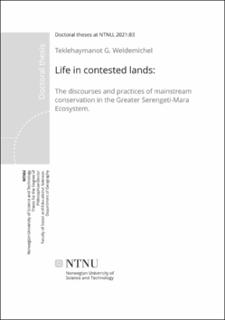| dc.contributor.advisor | Lein, Haakon | |
| dc.contributor.advisor | Benjaminsen, Tor Arve | |
| dc.contributor.author | Weldemichel, Teklehaymanot G. | |
| dc.date.accessioned | 2021-03-18T09:06:53Z | |
| dc.date.available | 2021-03-18T09:06:53Z | |
| dc.date.issued | 2021 | |
| dc.identifier.isbn | 978-82-326-6379-8 | |
| dc.identifier.issn | 2703-8084 | |
| dc.identifier.uri | https://hdl.handle.net/11250/2734073 | |
| dc.description.abstract | Tanzania and Kenya are renowned for their extensive safari tourism on vast protected areas teeming with diverse wildlife. The most celebrated of such destinations is the Greater Serengeti-Mara Ecosystem (GSME), which comprises the Serengeti National Park, the Maasai Mara National Reserve and a wide range of protected areas surrounding these across Northern Tanzania and southern Kenya. The GSME is also home to traditional pastoral and agro-pastoral communities. The main protected areas were established more than six decades ago on land that was curved out of what used to be shared by wildlife and people who were forced to settle in adjacent smaller and often sub-optimal areas.
Using four interrelated articles, this thesis provides nuanced critiques of the conservation policies and practices in the GSME. It argues that conservation in the region is guided by underlying narratives that emphasise the disconnections between humans and nature the origin of which can be traced to colonial history. Historically, such narratives resulted in the creation of protected areas that excluded local people. Following global calls to save dwindling wildlife numbers in recent years, governments and other conservation actors in Kenya and Tanzania have been working to include adjacent communal lands, into the more exclusive protected areas. In Kenya, the communal lands around protected areas were first privatized and then regrouped to form semi-private conservancies, causing waves of land use changes including widespread fencing in the remaining non-protected segments and dramatic shifts in livelihood pathways of the Maasai. In Tanzania, authorities use violence to expand protected spaces into what they call “buffer zone”, “corridors”, “dispersal areas”. In so doing, powerful actors cling on to global narratives about wildlife extinction and the role that population growth plays.
However, despite increasing expansion conservation areas, the conditions for wildlife and people around protected areas are deteriorating. As more land gets incorporated into protected areas through different tactics, portions of land which are left for human use become overburdened and inaccessible to wildlife due to fencing and conversion of land into non-traditional use.
The empirical material on which the analysis in this thesis is based comes from extended fieldworks in Kenya and Tanzania which took place between February 2017 and June 2019. | en_US |
| dc.language.iso | eng | en_US |
| dc.publisher | NTNU | en_US |
| dc.relation.ispartofseries | Doctoral theses at NTNU;2021:83 | |
| dc.relation.haspart | Paper 1: Weldemichel, Teklehaymanot; Lein, Haakon. "Fencing is our last stronghold before we lose it all." A political ecology of fencing around the Maasai Mara National Reserve, Kenya. Land Use Policy 2019 ;Volum 87.
https://doi.org/10.1016/j.landusepol.2019.104075 | en_US |
| dc.relation.haspart | Paper 2: Cavanagh, Connor Joseph; Weldemichel, Teklehaymanot; Benjaminsen, Tor A. Gentrifying the African Landscape: The Performance and Powers of for-Profit Conservation on Southern Kenya’s Conservancy Frontier. Annals of the American Association of Geographers 2020 ;Volum 110.(5) s. 1594-1612
https://doi.org/10.1080/24694452.2020.1723398
This is an Open Access article distributed under the terms of the Creative Commons Attribution-NonCommercial-NoDerivatives License (http://creativecommons.org/licenses/by-nc-nd/4.0/) (CC BY-NC-ND 4.0) | en_US |
| dc.relation.haspart | Paper 3: Weldemichel, Teklehaymanot.
Othering Pastoralists, State Violence, and the Remaking of Boundaries in Tanzania’s Militarised Wildlife Conservation Sector.
Antipode 2020 ;Volum 52.(5) s. 1496-1518
https://doi.org/10.1111/anti.12638
This is an open access article under the terms of the Creative Commons Attribution-NonCommercial License, (http://creativecommons.org/licenses/by-nc-nd/4.0/) (CC BY-NC 4.0) | en_US |
| dc.relation.haspart | Paper 4:
Weldemichel, Teklehaymanot.
Making land grabbable: Stealthy dispossessions by conservation in Ngorongoro Conservation Area, Tanzania.
The final published version is available in Environment and Planning E: Nature and Space 2021 s. 1-21
https://doi.org/10.1177/25148486211052860
This article is distributed under the terms of the Creative Commons Attribution 4.0 License (CC BY 4.0) | en_US |
| dc.title | Life in contested lands: The discourses and practices of mainstream conservation in the Greater Serengeti-Mara Ecosystem | en_US |
| dc.type | Doctoral thesis | en_US |
| dc.subject.nsi | VDP::Social science: 200::Human geography: 290 | en_US |
